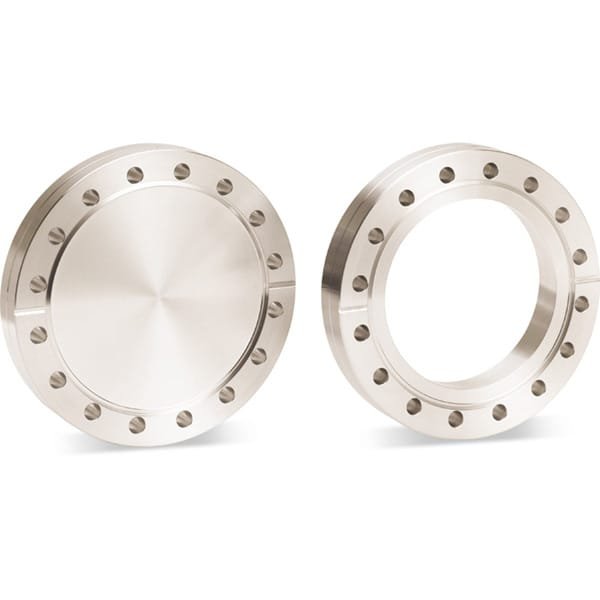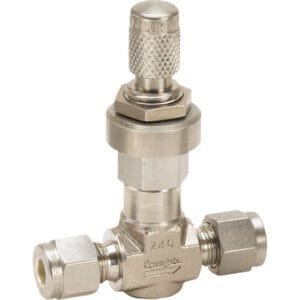Precision and Performance: DN160CF (8.00″ OD) 304L SS Standard ConFlat® UHV Flange from TFM
When it comes to constructing or maintaining a high-integrity ultra-high vacuum (UHV) system, the quality of every component is essential. That’s why TFM offers the DN160CF (8.00″ OD) 304L SS Standard ConFlat® Flange, a compact yet highly durable solution designed to deliver exceptional vacuum sealing and long-term reliability in demanding environments.
Designed for Ultra-High Vacuum Conditions
The DN160CF flange features an 8.00-inch outer diameter, making it a versatile choice for systems requiring a mid-sized yet robust vacuum interface. Built to ConFlat® (CF) standards, it incorporates a knife-edge sealing mechanism that, when paired with a copper gasket, ensures leak-tight, metal-to-metal seals down to pressures as low as 10⁻¹² Torr.
This makes it ideal for environments where maintaining vacuum integrity is critical—such as analytical instrumentation, surface science, and thin film deposition systems.
Constructed from High-Grade 304L Stainless Steel
At TFM, quality starts with the material. The DN160CF flange is manufactured from 304L stainless steel, prized for its corrosion resistance, strength, and clean weldability. Its low carbon content helps reduce the risk of carbide precipitation during welding, which in turn helps preserve vacuum integrity and structural performance.
TFM ensures each flange is CNC-machined to tight tolerances, offering precise surface flatness and sealing performance.
Key Features of the DN160CF Flange
Material: Durable and corrosion-resistant 304L stainless steel
Size: 8.00″ outer diameter – compact but highly compatible
Seal: Knife-edge CF design supports copper gasket for UHV sealing
Pressure Capability: Designed for UHV applications down to 10⁻¹² Torr
Standards: Fully compatible with other CF-standard flanges and hardware
Finish: Clean, precision-machined surface for secure installation
Applications in Advanced Industries
The DN160CF flange is a trusted choice for vacuum engineers and scientists across multiple disciplines, including:
Semiconductor and microelectronics fabrication
Synchrotron and accelerator facilities
R&D vacuum chambers
Spectroscopy and mass spectrometry systems
Laser optics and UHV-compatible optical benches
Its size and performance make it an ideal middle-ground solution between smaller and larger CF flanges.
Why Choose TFM?
TFM is committed to providing high-quality vacuum components backed by:
Reliable stock and fast shipping
Competitive pricing with no compromise on quality
Expert technical support and custom solutions
Strict quality control and material certification upon request
With TFM, you’re not just purchasing a flange—you’re investing in performance, consistency, and peace of mind.
Ordering Table
| Flange Size/OD | Type | Flange Material | Part Number |
| DN160CF (8.00" OD) | Fixed | 304L SS | F0800X000N |
| DN160CF (8.00" OD) | Fixed Tapped | 304L SS | F0800X000NM |
| DN160CF (8.00" OD) | Fixed Tapped | 304L SS | F0800X000NT |
| DN160CF (8.00" OD) | Rotatable | 304L SS | F0800X000R |
| DN160CF (8.00" OD) | Rotatable Tapped | 304L SS | F0800X000RM |
| DN160CF (8.00" OD) | Rotatable Tapped | 304L SS | F0800X000RT |
| DN160CF (8.00" OD) | Fixed | 304L SS | F0800X400N |
| DN160CF (8.00" OD) | Fixed | 304L SS | F0800X600N |
| DN160CF (8.00" OD) | Fixed Tapped | 304L SS | F0800X600NM |
| DN160CF (8.00" OD) | Fixed Tapped | 304L SS | F0800X600NT |
| DN160CF (8.00" OD) | Rotatable | 304L SS | F0800X600R |
| DN160CF (8.00" OD) | Rotatable Tapped | 304L SS | F0800X600RM |
| DN160CF (8.00" OD) | Rotatable Tapped | 304L SS | F0800X600RT |
| DN160CF (8.00" OD) | Fixed | 304L SS | F0800X608N |
| DN160CF (8.00" OD) | Fixed Tapped | 304L SS | F0800X608NM |
| DN160CF (8.00" OD) | Rotatable | 304L SS | F0800X608R |
| DN160CF (8.00" OD) | Rotatable Tapped | 304L SS | F0800X608RM |
| Flange Size/OD | Type | Flange Material | Part Number |





Reviews
There are no reviews yet.